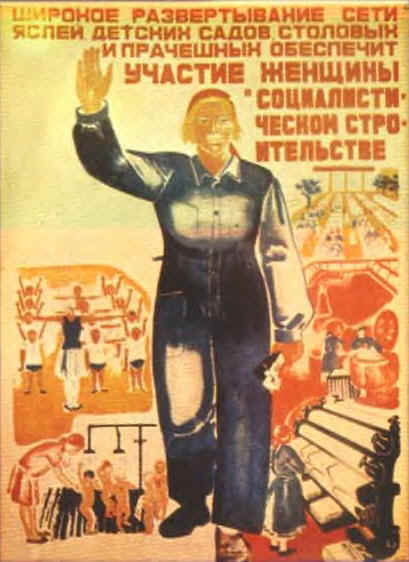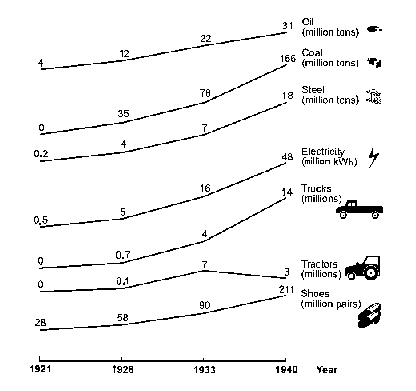Source A
Motives
for industrialisation
If
we are backward and weak, we may be beaten and
enslaved. But if we are powerful, people
must beware of us. We are 50 to 100 years
behind the advanced countries of the West.
We must make up this gap in 10 years.
Either we do this or they crush us.
from
a speech made by Stalin
to the First Conference of Workers in 1931
|
Question
1a
Why
did Stalin want to modernise Soviet industry? Explain your answer
using Source A and your own knowledge.
(6 marks)
|
Source
B

A
poster issued by The
Soviet
Government
in 1931.
The
poster says that more nurseries, laundries and
canteens mean that women can take part in industrial
growth.
|
Source
C
Working
conditions in the city of Magnitogorsk in the early
1930s
In
early April it was still bitterly cold, everything was
frozen. By May the city was swimming in
mud. Plague had broken out not far
away. People were in poor health because
of lack of food and overwork. Sanitary
conditions were appalling. By the middle
of May the heat had become intolerable.
from
Behind the Urals (1942) by John
Scott
John
Scott was an American engineer who voluntarily went to
Russia in the 1930s to help in the building of the
country.
|
Question
1b
Which
source, Source B
or Source C, is more useful to an
historian studying Stalin's policy of
industrialisation? Explain
your answer using Sources B and C and your own
knowledge.
(8 marks)
|
Source
D
Soviet
industrial production figures, 1921–40

This
chart is based on official Soviet statistics.
|
Question
1c
Is
Source D reliable as evidence about the effects
of the Five-Year Plans on Russian industrial
production?
Explain
your answer using Source D and your own knowledge.
(6 marks)
|
Source
E
The
Soviet people and industrialisation
The
Soviet people achieved so much in such a short
time. This happened because all the
country's wealth belongs to the working people who
create this wealth. The Stakhanovite
movement spread all over the country.
Thousands of workers produced more that their
quota. Miracles were created by the
enthusiastic work of the Soviet people.
from
a Soviet school textbook published in 1976.
|
Question
1d
Does
Source E give an accurate interpretation of the
impact of industrialisation on Russia in the period
1928–40?
Explain
your answer using Source E and your own knowledge.
(6 marks)
|
Question
1e
"Stalin's
policy of industrialisation was a success in the
period 1928
to 1941." Do
you agree or disagree with this interpretation?
Explain your answer using the Sources and your own
knowledge. (10 marks)
|
|